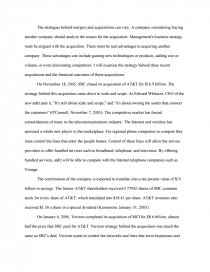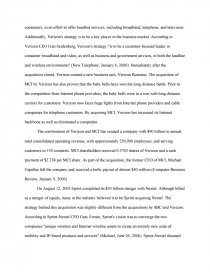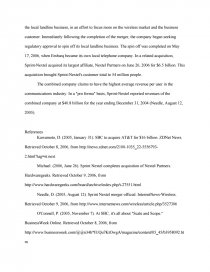Acquisitions
Essay by review • March 19, 2011 • Research Paper • 837 Words (4 Pages) • 1,697 Views
The strategies behind mergers and acquisitions can vary. A company considering buying another company should analyze the reason for the acquisition. Management's business strategy must be aligned with the acquisition. There must be real advantages to acquiring another company. These advantages can include gaining new technologies or products, adding size or volume, or even eliminating competitors. I will examine the strategy behind three recent acquisitions and the financial outcomes of these acquisitions.
On November 18, 2005, SBC closed its acquisition of AT&T for $16.9 billion. The strategy behind this acquisition came down to scale and scope. As Edward Whitacre, CEO of the new at&t puts it, "It's still about scale and scope," and "it's about owning the assets that connect the customers" (O'Connell, November 7, 2005). The competitive market has forced consolidations of many in the telecommunications industry. The Internet and wireless has spawned a whole new player in the marketplace. For regional phone companies to compete they must control the lines that enter the people homes. Control of these lines will allow the service providers to offer bundled services such as broadband, telephone, and television. By offering bundled services, at&t will be able to compete with the Internet telephone companies such as Vonage.
The combination of the company is expected to translate into a net present value of $15 billion in savings. The former AT&T shareholders received 0.77942 shares of SBC common stock for every share of AT&T, which translated into $18.41 per share. AT&T investors also received $1.30 a share in a special dividend (Kawamoto, January 31, 2005).
On January 6, 2006, Verizon completed its acquisition of MCI for $8.6 billion; almost half the price that SBC paid for AT&T. Verizon strategy behind the acquisition was much the same as SBC's deal. Verizon wants to control the networks and lines that serve businesses and consumers, in an effort to offer bundled services, including broadband, telephone, and television. Additionally, Verizon's strategy is to be a key player in the business market. According to Verizon CEO Ivan Seidenberg, Verizon's strategy "is to be a customer-focused leader in consumer broadband and video, as well as business and government services, in both the landline and wireless environments" (New Telephony, January 6, 2006). Immediately after the acquisition closed, Verizon created a new business unit, Verizon Business. The acquisition of MCI by Verizon has also proven that the baby bells have won the long distance battle. Prior to the competition from Internet phone providers, the baby bells were in a war with long distance carriers for customers. Verizon now faces huge fights from Internet phone providers and cable companies for telephone customers. By acquiring MCI, Verizon has increased its Internet backbone as well as eliminated a competitor.
The combination of Verizon and MCI has created a company with $90 billion in annual total consolidated operating revenue, with approximately 250,000 employees, and serving customers in 150 countries. MCI shareholders received 0.5743 shares of Verizon and a cash payment of $2.738 per MCI share. As part of the acquisition, the former CEO of MCI, Michael Capellas left the company and received a hefty payout of almost $40 million (Computer Business Review, January 9, 2006).
On August 12, 2005 Sprint completed its $35 billion merger with Nextel. Although billed as a merger of equals, many in the industry believed it to be Sprint acquiring Nextel. The strategy behind this acquisition
...
...



